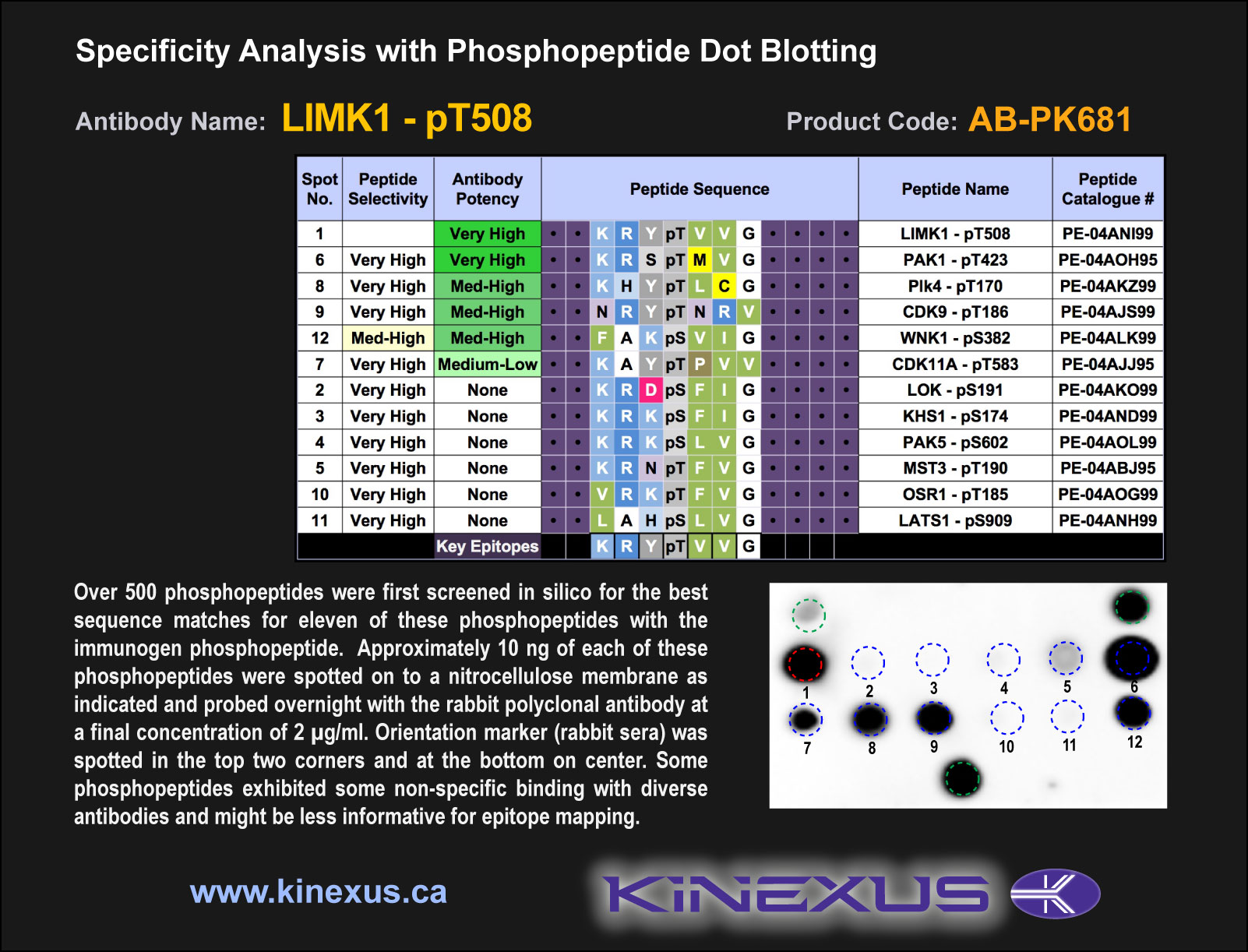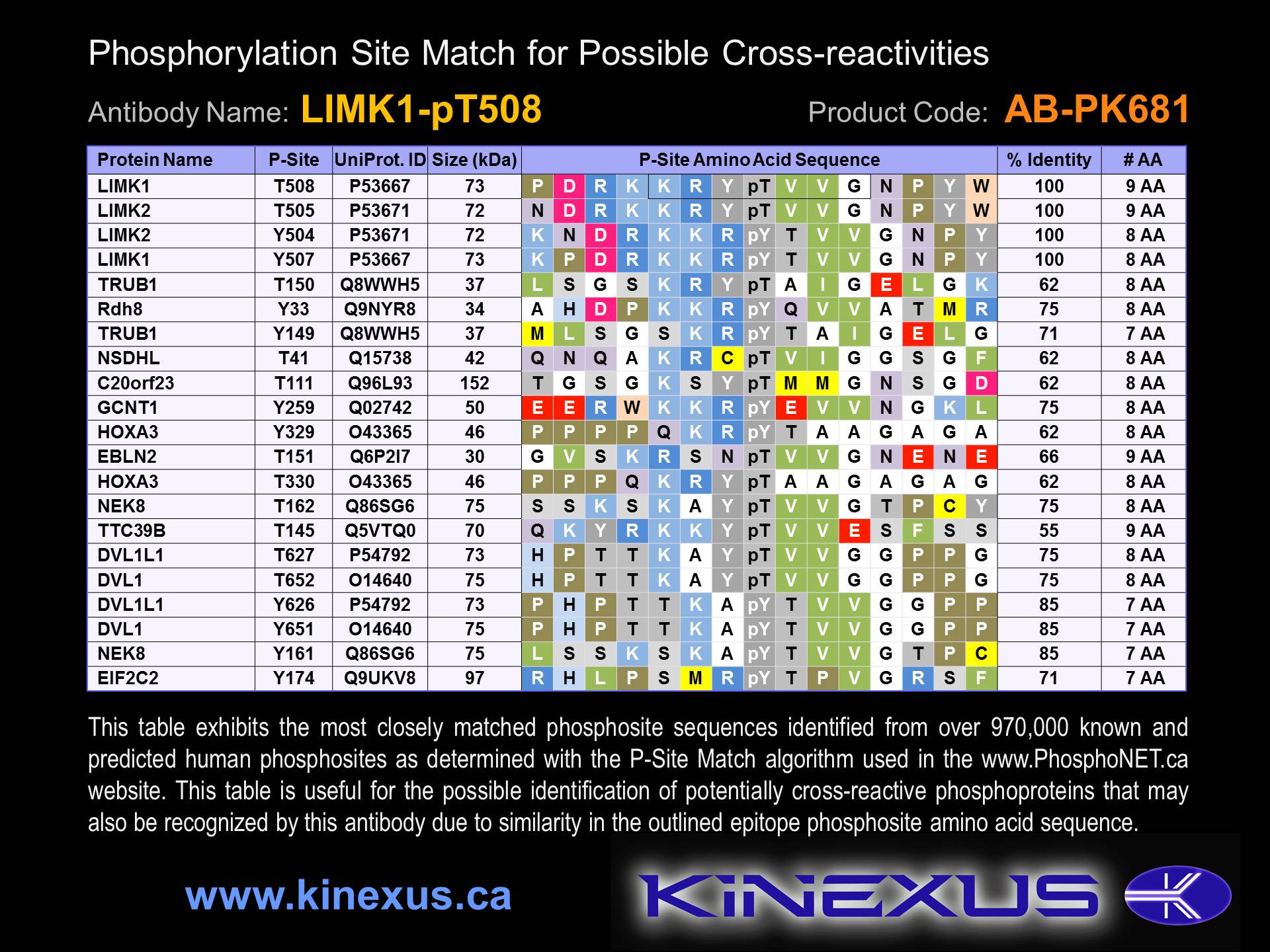Product Name: LIMK1-pT508
Product Number: AB-PK681
| Size: | 25 µg | Price: | 89.00 | |
| $US |
Target Full Name: LIM domain kinase 1
Target Alias: Kinase LIMK1; KIZ; KIZ-1; LIMK; LIMK-1; CCDS5563.1; P53667; Q75MU0; Q75MU4; ENSG00000106683
Product Type Specific: Protein kinase phosphosite-specific antibody
Antibody Code: PK681
Antibody Target Type: Phosphosite-specific
Antibody Phosphosite: T508
Protein UniProt: P53667
Protein SigNET: P53667
Antibody Type: Polyclonal
Antibody Host Species: Rabbit
Antibody Immunogen Source: Human LIMK1 sequence peptide Cat. No.: PE-04ANI99
Target Alias: Kinase LIMK1; KIZ; KIZ-1; LIMK; LIMK-1; CCDS5563.1; P53667; Q75MU0; Q75MU4; ENSG00000106683
Product Type Specific: Protein kinase phosphosite-specific antibody
Antibody Code: PK681
Antibody Target Type: Phosphosite-specific
Antibody Phosphosite: T508
Protein UniProt: P53667
Protein SigNET: P53667
Antibody Type: Polyclonal
Antibody Host Species: Rabbit
Antibody Immunogen Source: Human LIMK1 sequence peptide Cat. No.: PE-04ANI99
Antibody Immunogen Sequence: KRY(pT)VVG(bA)C
Antibody Immunogen Description: Corresponds to amino acid residues K505 to G511; In the protein kinase catalytic domain.
Antibody Immunogen Description: Corresponds to amino acid residues K505 to G511; In the protein kinase catalytic domain.
Production Method: The immunizing peptide was produced by solid phase synthesis on a multipep peptide synthesizer and purified by reverse-phase hplc chromatography. Purity was assessed by analytical hplc and the amino acid sequence confirmed by mass spectrometry analysis. This peptide was coupled to KLH prior to immunization into rabbits. New Zealand White rabbits were subcutaneously injected with KLH-coupled immunizing peptide every 4 weeks for 4 months. The sera from these animals was applied onto an agarose column to which the immunogen peptide was thio-linked. Antibody was eluted from the column with 0.1 M glycine, pH 2.5. Subsequently, the antibody solution was neutralized to pH 7.0 with saturated Tris.This antibody was also subject to negative purification over phosphotyrosine-agarose.
Antibody Modification: Unconjugated. Contact KInexus if you are interest in having the antibody biotinylated or coupled with fluorescent dyes.
Antibody Modification: Unconjugated. Contact KInexus if you are interest in having the antibody biotinylated or coupled with fluorescent dyes.
Antibody Concentration: 1 mg/ml
Storage Buffer: Phosphate buffered saline pH 7.4, 0.05% Thimerasol
Storage Conditions: For long term storage, keep frozen at -40°C or lower. Stock solution can be kept at +4°C for more than 3 months. Avoid repeated freeze-thaw cycles.
Product Use: Western blotting | Antibody microarray
Antibody Dilution Recommended: 2 µg/ml for immunoblotting
Antibody Potency: Strong immunoreactivity of a target-sized protein by Western blotting in A549 and MCF7 cells, andMedium detection in Jurkat and HepG2 cells. Very strong immunoreactivity with immunogen peptide on dot blots.
Antibody Species Reactivity: Human
Storage Buffer: Phosphate buffered saline pH 7.4, 0.05% Thimerasol
Storage Conditions: For long term storage, keep frozen at -40°C or lower. Stock solution can be kept at +4°C for more than 3 months. Avoid repeated freeze-thaw cycles.
Product Use: Western blotting | Antibody microarray
Antibody Dilution Recommended: 2 µg/ml for immunoblotting
Antibody Potency: Strong immunoreactivity of a target-sized protein by Western blotting in A549 and MCF7 cells, andMedium detection in Jurkat and HepG2 cells. Very strong immunoreactivity with immunogen peptide on dot blots.
Antibody Species Reactivity: Human
Antibody Positive Control: The observed molecular mass of the processed target protein on SDS-PAGE gels is reported to be around 72-78 kDa.
Antibody Specificity: Medium- very high
Antibody Cross Reactivity: No significant cross-reactive proteins detected in A549 cells and very little in HepG2 and MCF7 cells. In HEK-293 cells, phenylarsine oxide (PAO) decreased 100 + 80 kDa proteins; in Jurkat cells, PAO increased 50 + 60 kDa proteins, and PAO decreased 110 + 95 kDa proteins. In MCF7 cells, insulin increased detection of a 75 kDa protein.In sea star oocytes undergoing meiotic maturation, at least four strong cross-reactive proteins of ~90, ~140, ~200 and ~250 kDa were evident.
Related Product 1: LIMK1-pT508 blocking peptide
Antibody Specificity: Medium- very high
Antibody Cross Reactivity: No significant cross-reactive proteins detected in A549 cells and very little in HepG2 and MCF7 cells. In HEK-293 cells, phenylarsine oxide (PAO) decreased 100 + 80 kDa proteins; in Jurkat cells, PAO increased 50 + 60 kDa proteins, and PAO decreased 110 + 95 kDa proteins. In MCF7 cells, insulin increased detection of a 75 kDa protein.In sea star oocytes undergoing meiotic maturation, at least four strong cross-reactive proteins of ~90, ~140, ~200 and ~250 kDa were evident.
Related Product 1: LIMK1-pT508 blocking peptide
Scientific Background: LIMK1 is a protein-serine/threonine kinase of the TKL group and LISK family. It can modulate actin filament actions. Upstream kinases from LIMK1 include ROCK1, PAK1 and PAK4 and LIMK1 is activated via phosphorylation of an active-site threonine. Phosphorylation at S323 and T508 increases phosphotransferase activity.Activation of LIMK1 by ROCK1 can be fully inhibited with a T508A mutation. LIMK1 will directly act on CFL1 (cofilin-1), CFL2 (cofilin-2), and DSTN (destrin), preventing the ability of these cytoskeletal proteins to polymerize. It also catalyzes an inactivating phosphorylation on TPPP to inhibit depolymerization and destablilization of actin and tubulin. It is involved in cell motility, cell morphology, cytokinesis and cell cycle progression. Overexpression leads to developing invasive phenotype and metastasis of cancers. Cell cycle progression, motility, and differentiation are all affected by this inhibited actin polymerization. In LIMK1, the mutations C84S, G177E + L178A, and T508EE can enhance aggregation of actin whereas D460N, and R503G + K504A + K505A will fully inhibit actin aggregation and T508V/E will partially inhibit actin aggregation.
Figure 1. Epitope mapping of LIMK1-pT508 antibody with similar phosphopeptides on dot blots.
Figure 2. Identification of phosphosites related to LIMK1-pT508.
© Kinexus Bioinformatics Corporation 2017



